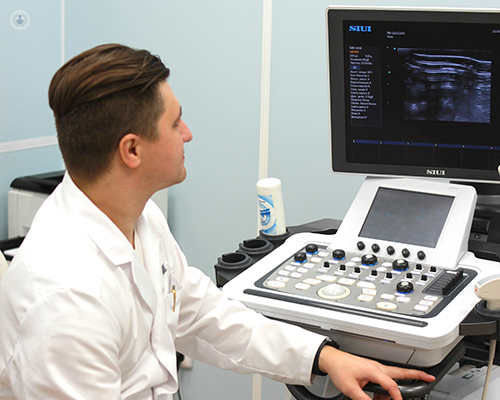What is a medical ultrasound?
Autore:A medical ultrasound is a non-invasive imaging technique that can provide real-time, detailed images of internal structures within the body.
Here, Dr Francis Kynaston-Pearson, renowned consultant rheumatologist, offers an expert insight into a medical ultrasound and its role in diagnostics.

How does a medical ultrasound work?
During a medical ultrasound, a small handheld device known as a probe is used to generate images of the body part being examined. It achieves this by emitting very high-frequency sound waves. These sound waves then bounce back into the probe, where they are detected by the probe’s sensors. This is similar to how a bat or submarine uses sound waves to navigate.
After, the reflected signals are analysed and processed by the ultrasound machine into an image. Further technology, such as the “doppler mode”, can then detect subtle inflammation that may not be evident on examining the area (for example, the joint) by clinical examination alone.
Why would I need a medical ultrasound?
A medical ultrasound isn’t necessary in every case. Many patients have obvious inflammation which can be diagnosed without the need for an ultrasound, while others may have non-inflammatory issues (for example, hypermobility) where an ultrasound is less likely to be of value.
A medical ultrasound can nonetheless be a very helpful test, especially when it comes to inflammatory conditions that involve the joints. This is because it can pick up subtle changes inside the joints or changes in blood flow that suggest inflammation at a very early stage. Thus, not only can a medical ultrasound examination be used for early diagnosis, but it can also be helpful for monitoring response to treatment.
Additionally, a musculoskeletal ultrasound is helpful when detecting damage such as tendon tears, and it can be used to accurately guide a therapeutic injection into the right area, optimising outcomes whilst minimising risks.
Another major benefit of an ultrasound is that it doesn’t use any radiation, unlike X-rays or CT scans, and the examination is cheaper and faster to perform than other investigations such as MRI scans.
How is a medical ultrasound performed?
This will obviously depend on the area being scanned, but the most common scan performed in rheumatology is that of the hands and wrists due to the frequency of findings in this area early on in inflammatory arthritis. The process involves the following:
- Jelly is placed on the wrist and the knuckles to help conduct the ultrasound sound waves from the probe into the tissue around the joints.
- Scanning takes place up and down, then side to side, and across the edges of the wrist. The knuckles at the base of the fingers are commonly scanned, and selected joints within the fingers are also scanned.
- Images are often captured in “B mode”, which takes a 2-dimensional image, with the use of the “doppler mode”, which adds a colour annotation over this image wherever subtle movement is detected - highlighting the increased blood flow of inflammation.
- Occasionally, other related areas may be scanned as part of the scan, for example the palm side of the hand to look at the tendons or, when present, any lumps to see if they appear on the scan (for example, a ganglion cyst).
The images of the ultrasound will show up in black-and-white on a screen, and the patient might be able to see the movement of the tendons over the bones of the hand. The patient will also be able to see inside of the joint; however, an ultrasound doesn’t have the ability to look inside of the bone itself. If there is a change in the joint, we may see puffiness or a change to the grey colour of the tissue around the tendons.
The “doppler” images will appear as a square box over the images. It uses a principle of physics (known as the “doppler effect”) to detect motion that is taking place, and it can also detect whether this is moving towards or away from the probe. The clinician may use power “doppler” (detects movement) or colour “doppler” (detects movement and direction), depending on their preference and machine set up. This will appear either as a bright orange spot or as red and blue spots on most machines, denoting where there is movement, which might be inflammation.
Not all “dopplers” are bad. There are areas where we would normally expect to detect “doppler” (for example, over a blood vessel) and this test is also extremely sensitive, so any movement of the probe will also appear as a “doppler”. The patient may thus be asked to remain very still or even not talk when the clinician performs “doppler”, so that they can be sure that what they are seeing is accurate and not an “artefact”, which is the term used when misleading information is being detected (for example, from excess movement of the hand).
How can I request a medical ultrasound?
If a medical ultrasound is felt to be beneficial, I would usually recommend that you come back for another assessment as the scan takes a minimum of 20 minutes per area to perform. If multiple areas are to be scanned (for example, the hands, wrists, feet and ankles) a longer appointment will be needed. Images are stored and can be purchased if desired for an additional fee.
If you are concerned you have arthritis that might be inflammatory, I offer a combined assessment for new self-pay patients that lasts 60 minutes. This has the advantage of being a “one-stop” assessment on the same day rather than attending a second appointment, and is cheaper for self-pay patients. However, during the one-stop clinic, it might not be possible for time reasons to store images and, instead, the scan will be used to enhance the clinical examination.
If you are unsure, the best thing is to book a 40 minute review, and I can let you know if a medical ultrasound will be beneficial.
To schedule an appointment with Dr Francis Kynaston-Pearson, head on over to his Top Doctors profile today.


